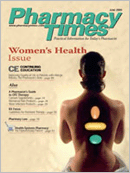Publication
Article
Pharmacy Times
Look-Alike Name Confusion
Author(s):
Amantadine and Memantine
During a recent internship, a pharmacystudent was asked by 2 physiciansand 1 pharmacist for "informationabout the newer drug to treatAlzheimer's disease, amantadine."Thestudent initially responded by sayingthat she thought that amantadine(Symmetrel) had been around for awhile. That drug is indicated in the prophylaxisand treatment of signs andsymptoms of infection caused by variousstrains of influenza A virus and inthe treatment of parkinsonism anddrug-induced extrapyramidal reactions.
After investigating, however, the studentrealized that the medication inquestion was actually memantine(Namenda). It is indicated for the treatmentof moderate-to-severe dementia ofthe Alzheimer's type. It became availablein the United States in January 2004.
Normodyne and Norpramin
At a community pharmacy, awoman presented a prescription forwhat was supposed to be Normodyne(labetalol) 100 mg bid, but it was misinterpretedas the tricyclic antidepressantNorpramin (desipramine) 100 mgbid. After taking 1 dose, the womanexperienced nausea, blurred vision,sweating, and hand tremors.
Subsequently, she performed a computersearch on Norpramin. Because sheknew that she was supposed to receivean antihypertensive, she realized thatshe was given the wrong medication.Similarities in the drug name, dosage,and frequency of administration likelycontributed to the error. The error mighthave been avoided if adequate counselingor a medication information leaflethad been provided at the pharmacy.
Avinza and Evista
Beware of look-and sound-alikeproblems between Avinza (morphinesulfate extended release), used in thetreatment of moderate-to-severe pain,and Evista (raloxifene), used in thetreatment and prevention of osteoporosisin postmenopausal women. Ina recent error, a pharmacist received ahandwritten physician's order for Avinza60 mg daily; however, the order wasmisinterpreted as Evista 60 mg daily.
The patient was a 75-year-oldfemale, so the error was not immediatelyrecognized. The error was discovered2 days later when the physicianwrote an order to increase theAvinza to 90 mg daily because thepatient's pain was not controlled.Similarities in the drug names, overlappingdosage (60 mg), and similaronce-daily dosing likely contributedto the error. Had the prescriber listedthe indication for the medication onthe order, it would have helped to preventthis error. Because of the soundalikepotential, these drug namesshould be spelled out when givingtelephone or verbal orders.
Norvasc and Navane
A patient admitted to a psychiatryservice had orders written for fluoxetine60 mg daily and what appeared tobe Norvasc (amlodipine) 5 mg twicedaily. One dose of Norvasc was dispensedand administered before anurse contacted another pharmacistto request a missing dose of Navane(thiothixene). The pharmacist reviewedthe patient's profile and didnot see an order for Navane. Henoticed an order for Norvasc, however,for the same strength and frequency.The pharmacist, who was aware ofreported mix-ups between theseagents, retrieved the original orderand discovered that, indeed, the orderwas for Navane, not Norvasc.
The correct drug was dispensed, andthe nursing staff was alerted to observethe patient for possible hypotensionover the next 12 to 24 hours. Thepatient experienced no apparentadverse effects from the Norvascadministration or from the temporarydelay in receiving Navane.
When Norvasc was first marketed, theInstitute for Safe Medication Practicesreceived numerous reports about erroneousdispensing of Navane. Now thatNorvasc is so widely used, the oppositemix-up occurs more frequently. Thisreport should serve as a reminder thatthis pair of look-alike names continuesto present problems.
Dr. Kelly is the editor of ISMPMedication Safety Alert! Community/Ambulatory Care Edition.
Report MedicationErrors
The reports described here werereceived through the USP MedicationErrors Reporting Program, which is presentedin cooperation with the Institutefor Safe Medication Practices (ISMP).ISMP is a nonprofit organization whosemission is to understand the causes ofmedication errors and to provide time-criticalerror-reduction strategies to thehealth care community, policy makers,and the public. Throughout this series,the underlying system causes of medicationerrors will be presented to help readersidentify system changes that canstrengthen the safety of their operation.
If you have encountered medicationerrors and would like to reportthem, you may call ISMP at 800-324-5723 (800-FAILSAFE) or USP at 800-233-7767 (800-23-ERROR). ISMP'sWeb address is www.ismp.org.
Subscribe toNewsletter
Pharmacy Times and the Institutefor Safe Medication Practices (ISMP)would like to make community pharmacypractitioners aware of a publicationthat is available.
The ISMP Medication Safety Alert!Community/Ambulatory Care Edition isa monthly compilation of medicationrelatedincidents, error-prevention recommendations,news, and editorialcontent designed to inform and alertcommunity pharmacy practitioners topotentially hazardous situations thatmay affect patient safety. Individualsubscription prices are $45 per yearfor 12 monthly issues. Discounts areavailable for organizations with multiplepharmacy sites. This newsletter isdelivered electronically. For more information,contact ISMP at 215-947-7797, or send an e-mail message to[email protected].







